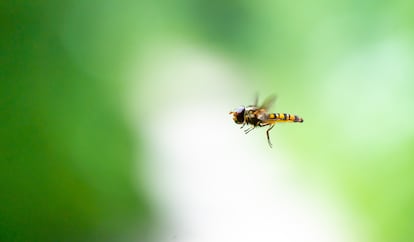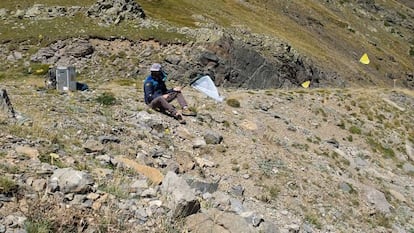The 30-meter pass in the Pyrenees through which millions of insects migrate
Scientists from the University of Exeter have documented the massive movement of arthropods through Bujaruelo, where researchers detected up to more than 3,000 flies per meter and minute
Scientists from the University of Exeter have confirmed the massive migration of millions of insects through a pass measuring just 30 meters in the Pyrenees mountains, on the border between Spain and France. According to a study published in Proceedings of the Royal Society B, more than 17 million arthropods cross every year through Bujaruelo, a Pyrenean pass in Huesca at 2,273 meters of altitude between Taillón Peak (3,144 meters) and Pic Entre Les Ports (2,476 meters). A wide variety of species migrate through this spot, from large dragonflies to tiny flies.
“What we found was truly extraordinary,” says Will Hawkes, lead author of the study and researcher at the University of Exeter, who claims that some days they recorded more than 3,000 flies per meter and minute. As the scientist explain by email, “this Bujaruelo pass is important because it constitutes the easiest route for flying insects as they travel through the high Pyrenees.” However, he explains this pass is likely to be one of the many routes that insects follow to cross the mountains. “Insects are channeled through the steep mountain valleys and then through the hills, since they are much lower than the peaks,” says Hawkes. “There are probably many more passes, all with millions of insects migrating each fall.”

The first time the massive migration of insects was detected at this site was in the autumn of 1950, more than 70 years ago, when ornithologists Elizabeth and David Lack came across “an incredible spectacle of insect migration” at the Bujaruelo pass, says Hawkes. This was the first recorded case of fly migration in Europe. While there was a high number of the species Episyrphus balteatus, there were many other insects other than flies, such as butterflies and dragonflies. To analyze this phenomenon, the Exeter researchers took data from the site every autumn for four years, monitoring a large number and variety of diurnal flying insects heading south.
The findings from this single pass suggest that billions of insects cross the Pyrenees each year, making the mountain range a key location for many migratory species. Normally, insect migration studies are limited to specific taxa such as butterflies, moths or dragonflies. Works that document joint migrations with very different species are rare. “This is because the small insects that migrate are usually invisible in an extensive landscape, requiring specialized equipment such as entomological radars or nets supported by balloons for their detection,” explains Hawkes. However, there are some sites, such as Bujaruelo pass, which are migratory bottlenecks due to their topographical conditions. By focusing on this site, the massive migration of arthropods could be studied much more completely.
As Hawkes details, in 2018 they returned to Bujaruelo to check if the migration detected by Elizabeth and David Lack was still happening and to record the number of individuals and variety of species. More than 70 years later, the passage of arthropods continued to produce a fascinating spectacle. Over the next four autumns, the researchers used a video camera to count small insects, a visual count to quantify butterflies, and a flight interception trap to identify migrating species. According to the results, of the 17 million insects counted, the vast majority (89%) were dipterans such as flies, but a large number of butterflies or dragonflies were also observed. “These insects would have started their journey further north into Europe and continued south to Spain and perhaps beyond during the winter,” says Hawkes. These small migratory insects that make incredible journeys are vital for the planet, both in terms of pollination and the transfer of nutrients.

“Seeing so many insects moving decisively in the same direction at the same time is one of the great wonders of nature,” says Karl Wotton, another of the researchers who participated in the study. According to the study, insect numbers peaked when conditions were warm, sunny and dry, with low wind speeds and headwinds to keep the insects low over the pass so they could be counted.
Enrique Murria Beltrán, an entomologist expert in lepidopterans, points out that migratory insects usually fly north in spring, explaining that the British researchers investigated their return in the fall. “The scientific work is very good, I knew that the pass of Bujaruelo was an important pass for butterflies, but I didn’t know that it was so special,” he says. “The only shame is that these studies have to be done by foreigners, because here [in Spain] we small researchers are on the brink of unemployment.”
Constanti Stefanescu, coordinator of the Catalan Butterfly Monitoring Scheme (CBMS), a biodiversity monitoring network that collects data on butterflies, also says that the work is very innovative. “We are in the 21st century, and we didn’t know anything about this, for the first time the groups of insects that cross through that pass have been quantified,” he says. The author did other similar work in Cyprus and “both studies show that there is an impressive seasonal movement towards higher latitudes in spring and summer to find optimal places to breed, while in late summer and autumn they go to lower latitudes.”
Although quantitatively there are millions of tons in motion, the insects that undertake these journeys are a small part of the species that exist. “In the case of butterflies, for example, of the 240 diurnal species that exist in Spain, no more than a dozen are involved in these migratory movements,” explains Stefanescu.
For him, what’s important is recognizing that there are millions of individuals of species, “some very common,” that travel great distances. And all that moving biomass serves as food for predators, other insects and birds. “In addition, these flies are pollinators and can transport pollen many kilometers, which allows the genetic diversity of plants to increase,” adds Stefanescu. He also warns that some of these species may be agricultural pests. “It is an open field, and there is much to do. This study focuses on the movement of populations from the center and north to the south, but it is not yet known what happens in spring, when the journey is likely to be the other way around,” he explains.
Sign up for our weekly newsletter to get more English-language news coverage from EL PAÍS USA Edition
Tu suscripción se está usando en otro dispositivo
¿Quieres añadir otro usuario a tu suscripción?
Si continúas leyendo en este dispositivo, no se podrá leer en el otro.
FlechaTu suscripción se está usando en otro dispositivo y solo puedes acceder a EL PAÍS desde un dispositivo a la vez.
Si quieres compartir tu cuenta, cambia tu suscripción a la modalidad Premium, así podrás añadir otro usuario. Cada uno accederá con su propia cuenta de email, lo que os permitirá personalizar vuestra experiencia en EL PAÍS.
¿Tienes una suscripción de empresa? Accede aquí para contratar más cuentas.
En el caso de no saber quién está usando tu cuenta, te recomendamos cambiar tu contraseña aquí.
Si decides continuar compartiendo tu cuenta, este mensaje se mostrará en tu dispositivo y en el de la otra persona que está usando tu cuenta de forma indefinida, afectando a tu experiencia de lectura. Puedes consultar aquí los términos y condiciones de la suscripción digital.
More information
Archived In
Últimas noticias
Welcome to the post-religion era: The idea of Christianity as the absolute truth has become obsolete
‘I thought you would like it’: The risky sexual practice popularized by TV shows and TikTok
The digitalization of tourism: ‘They promise experiences and gave us the worst possible one’
Mexican peso defies uncertainty with forecasts of a new period of stability in 2026
Most viewed
- Sinaloa Cartel war is taking its toll on Los Chapitos
- Reinhard Genzel, Nobel laureate in physics: ‘One-minute videos will never give you the truth’
- Oona Chaplin: ‘I told James Cameron that I was living in a treehouse and starting a permaculture project with a friend’
- Why the price of coffee has skyrocketed: from Brazilian plantations to specialty coffee houses
- Silver prices are going crazy: This is what’s fueling the rally












































